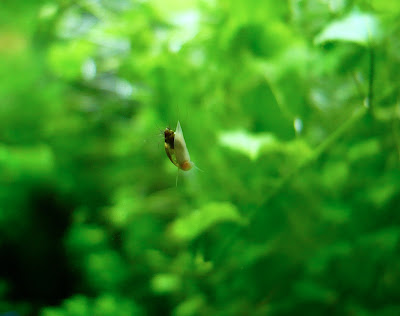Da un paio d'anni a questa parte utilizzo per le foto all'aquario una fotocamera compatta Panasonic Lumix DMC-LS60 sulla quale non posso che spendere elogi. Le foto sono fantastiche e con un ottima definizione e fedeltà di colori.
Come tutte le compatte di basso costo ha un limite notevole che risulta molto penalizzante quando si tratta di fotografare un acquario: non è possibile regolare manualmente la velocità di scatto e/o l'apertura focale.
I problemi nel fotografare un acquario sono di due tipi:
- Luce: non è mai abbastanza e non è possibile rimediare con il flash a causa della riflessione sui vetri
- Soggetti: i pesci richiedono alte velocità per evitare il "mosso", per le piante spesso è necessario, al contrario, prediligere una maggiore profondità di campo.
Escludendo le varie modalità automatiche che non permettono alcun controllo sui parametri il limite della LS60 è che anche in modalità manuale non sono previste regolazioni su tempi e focali. In tale modalità (come nella modalità macro) si possono modificare solo il bilanciamento del bianco, gli "ISO" (100 -> 3200) e la compensazione exposure (+2 to -2 in steps of 1 / 3). In fact, the only possible intervention seems to be the adjustment of the ISO that allows you to vary the times at the expense of image quality caused by noise.
To better understand how to manage and evaluate all the opportunities to increase the light I run an experiment:
Late at night, with no ambient light, I lit a lamp 150w and I have placed under a white card. This gave me a source of scattered light intensity constant. I place the machine at 50 cm from the card by putting it in focus, and I started to transcribe the various apertures and focal time indicated by the machine to change the ISO.
result was a multiplication table as follows:
| ISO | foc | time (s) |
| 100 | 2.8 | 1 / 4 |
| 200 | 2, | 8 1 / 8 |
| 400 | 2.8 | 1 / 15 |
| 800 | 2.8 | 1 / 30 |
| 2000 | 2.8 | 1 / 60 |
Surprise! The macchina non adegua focale e tempo ma solo il tempo mantenendo sempre la focale a 2,8 (apertura massima).
Questo mi porta a due considerazioni. Primo: per quanto possa manipolare i parametri la macchina tenderà sempre ad aprire la focale al massimo andando a ridurre la profondità di campo. Secondo: in base alla prima considerazione non ha senso variare di molto gli ISO se non fino alla velocità di scatto minima necessaria per riprendere un pesce (fattore che dipende molto dalla mobilità dello stesso in quel momento).
Quindi si ottiene un risultato migliore evitando di spaventare il soggetto rispetto a qualsiasi regolazione possibile sulla macchina la dimostrazione è nei due scatti seguenti; entrambi con f 5,0 e t 1/8s,
nel primo il soggetto era spaventato e in movimento

nel secondo, decisamente più ben riuscito l'esemplare era quasi immobile...

Per le piante la situazione invece è grave a causa della scarsa profondità di campo. Quindi l'esperimento è continuato, in quanto, mi sono chiesto cosa sarebbe successo zoomando visto che, normalmente, l'adozione di uno zoom riduce l'apertura focale.
Quindi ho mantenuto costante l'impostazione degli ISO a 200 e ho provato a zoomare ecco il risultato:
| Zoom | foc | time (s) |
| 1x | 2.8 | 1 / 4 |
| 2x | 4.3 | 1 / 4 |
| 3x | 5.0 | 1 / 4 |
then changing the zoom you can vary the depth of field (at the expense of the return) even if the range is not large as the machine allows openings 2.8 -> 5.0.
However, when the subject of the shot is in the foreground and you want to isolate it from the rest of Aperture 2.8 can also be handy: in this shot, wanting to highlight the bubbles of oxygen, I used the macro taking the sensitivity as low as possible (200 ISO). The machine is set to f 2.8 t 1/15s and the result is certainly decent ...

Maybe I could have gone down to 100 ISO but not always when shooting are unable to have control of all parameters.







